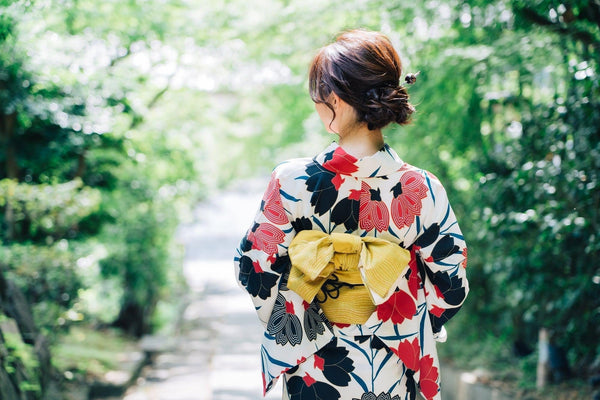
Jump to:
Two of the most popular traditional Japanese things to wear are the kimono and the yukata. In a time when most Japanese people wear Western style clothing (called yōfuku in Japanese), they still wear some traditional clothing (wafuku), too. The kimono and yukata have a long history that began in ancient times. They are quite similar to each other, as well — in fact, a yukata is a type of kimono. This article will tell you all about the differences between the two - their origins, materials, accessories, and differences.
Note: This article will use kimono and yukata as the plural and singular form of the words. This is how it’s used in Japanese (so, no “kimonos” or “yukatas” will be seen in this article - but you’re not incorrect if you say it with an “s”).
What Is A Kimono?

A kimono is a traditional Japanese garment that is usually worn at special events or ceremonies like weddings, graduations or even funerals. It is probably the most famous of all traditional Japanese clothing. It is often called the “national dress of Japan.” The word kimono means “a thing to wear.” It’s usually considered formal wear (haregi in Japanese) — especially when compared with the yukata — and is most often made from silk (although other materials are used, as well, including something called chirimen - aka crêpe).
What Is A Yukata?

A yukata is actually a type of kimono, but it’s a very casual version of one (so casual that it was originally used for bathing). People often wear yukata in the summer — especially (but not only) for summer festivals. Because it’s more casual than a kimono, it’s also less expensive. This can make it a good choice for travelers who want to buy traditional Japanese clothing, but don’t want to make a big financial investment.
What Is The Difference Between A Kimono And A Yukata?

There are some key differences between yukata and kimono, but keep in mind the yukata is a type of kimono (so there are many similarities, too). One difference is that yukata are usually worn in the summer - often for festivals. Kimono can be worn at festivals, too, but they are still seen as fancier than yukata. Also, kimono are worn for very special occasions (like a wedding, for example). Yukata, on the other hand, are so casual that they are sometimes worn at onsen, (Japanese hot springs). So, with yukata, think casual — with kimono, think formal!
Another difference between yukata and kimono is how many layers you wear. A yukata is usually just one layer of fabric with nothing underneath, while you would wear a kimono with multiple layers. You would usually wear a kimono with an undergarment called the nagajuban. (Japan Talk goes into the nagajuban in detail, if you’d like to know more about it).
Yet another difference between the yukata and kimono is the material they are made of. Kimono are mostly made from more expensive fabrics like silk. Yukata, on the other hand, are usually made from less expensive fabric like cotton. However, there are always exceptions, and some kimono and yukata creators use different fabrics.
Differences Between Kimono for Men and Women
There are quite a few differences between kimono for men and women. One notable difference between men's and womens’ kimono are the colors and print choices. Women tend to have brighter and more colorful kimono, while men often have more solid colors in toned-down hues (of course there are exceptions!).
Another difference is that the accessories men and women use with their kimono are different. For example, with the obi (the belt that wraps around the kimono), there are many different types for men and women. A woman’s obi can be tied in different ways than a man’s — and the obi is only one of the many possible accessories you could wear with a kimono. See the accessory section of this article for a full rundown.
One final difference between the kimono for men and women is in the collar. When women put on a kimono they usually show a bit of neck in the back — traditionally, men don’t.
Differences Between Yukata for Men and Women
As with the kimono, the collar and belt on a yukata are styled differently for men and women. Also, there tend to be more yukata patterns available for women than men (as you can see in this yukata rental site for Saitama’s Sota City). Most of the differences between women’s and men’s yukata are the same as those listed above for the kimono. Remember, the yukata is a type of kimono.
The History Of The Kimono And The Yukata

Kimono history goes all the way back to the eighth century. According to the Ministry of Foreign Affairs of Japan, “Kimono as we know them today came into [their current] form during the Heian period (794-1185).” Before the year 794, Japanese men and women would usually wear a long top with long pants or a skirt underneath. They sometimes wore one-piece garments, as well. But, when the kimono came into style it replaced the previous fashions.
However the kimono (this includes the yukata — a type of kimono) at this time wasn’t exactly like it is today. By the Muromachi period (1336-1573), a short sleeved kimono-like garment called the kosode (“small sleeves”) was popular. A kosode was originally worn as underwear or sleepwear. According to historian Cynthia Green, “During the Edo era, kosode was a visibly unifying cultural marker. Every Japanese person wore it, regardless of age, gender, or socio-economic position.”
The kosode eventually developed into the longer-sleeved kimono, and it became the popular clothing style of Japan. People wore kimono that indicated their class, their personal fashion sense and even indicated the family they belonged to. To this day, people still value kimono for their beauty and cultural significance.
What Are The Different Types Of Kimono?
There are many types of kimono (including the yukata). Types include the furisode, tomisode, houmongi and many more. The type of kimono one wears varies based on personal taste, occasion, season and level of formality.
What Accessories Are Worn with a Kimono and a Yukata?
There are various accessories you can wear with kimono or yukata. They include everything from underwear to belts to fans. This is a list of the most common kimono accessories you’ll see.
Haori - The Jacket

Haori is a short jacket that is sometimes worn over a kimono. It is usually tied together with haori himo. Haori himo are not actually a belt. They are a set of short cords that are attached to the haori that tie together. Haori used to be specifically worn by men, but in the 1800s women started to wear them, too.
Nagajuban - The Underwear

With the kimono specifically, you wear an undergarment called the nagajuban. Japan Talk has an interesting article on nagajuban with photos, if you’re interested.
Hakama - The Pants

Hakama are a sort of trousers that are worn over a kimono. They are worn by men and women, depending on the time period, occupation and occasion.
Kanzashi - The Hairpin

Kanzashi are hairpins used in traditional Japanese hairstyles. There are many different types and styles of kanzashi, and the materials used to make them vary widely, as well. Kanzashi are almost exclusively worn by women.
Geta and Zori - The Shoes

Hear that “click” “clock” sound on the pavement? See someone in a kimono walking by? They’re probably wearing zori! Zori are usually worn with formal kimono. You will probably hear that same “click” “clock” sound if someone walks by in a yukata. But, they’re more likely wearing geta. Geta are also traditional Japanese wooden-soled shoes. They are commonly worn with yukata, but you see more casual footwear these days, too - including tennis shoes, flip-flops, etc. Both zori and geta come in so many varieties and materials. Check out this article by Matcha if you want to learn more about them.
Obi - The Belt

Both yukata and kimono require a belt (you might also call it a sash). This belt is called an obi. The obi varies in size and style, depending on the garment, your gender and the occasion. There is so much diversity among obi belts. We have the heko obi (more informal), fukuro obi (more formal), and tsuke obi (popular for children) — and that is only scratching the surface! For an extensive list of obi (and the many ways to tie them), check out this page.
Kinchaku - The Bag

The kinchaku is a traditional Japanese bag with a drawstring that is used to carry your things in. It’s very simple and usually matches the kimono or yukata you’re wearing.
Sensu, Ōgi or Uchiwa - The Fan

The traditional folding fan that is often carried or used while wearing a kimono can be called a sensu or ōgi. Sometimes people carry uchiwa, too — a flat, nonfoldable fan.
Do People Style Their Hair Specifically for Wearing a Kimono or Yukata?
Japanese people almost always style their hair when wearing a kimono. When wearing a yukata, stylish hair is not always necessary (depending on the situation). Kimono hairstyles vary, but they tend to be nihongami (traditional Japanese hairstyles). Japanese hairstylist Shuhei Tanaka gives a beautiful demonstration on how to style hair for a kimono on YouTube. It’s interesting to see how he uses “hair padding” to give the kimono hairstyle more volume.
How To Wear A Kimono Or Yukata

There are some set rules for wearing kimono and yukata. One rule is that you should always fold it left side over right. The only way you’d fold it the other way is if you were dead (and we hope you aren’t!). There are also rules that vary by gender. For the kimono, specifically, there is a guide for men on Old Japan and a guide for women on Voyapon. For yukata, specifically, check out this video tutorial for both men and women.
Which One Should I Buy - A Kimono Or A Yukata?
You should buy a kimono if you want something more formal (and expensive). You should buy a yukata if you want something more casual and affordable. You should also consider what your kimono or yukata will be used for:
- A very special occasion? Probably a kimono.
- A summer festival? Probably a summer yukata.
- Going to the bar with friends? Depends on how much you want to impress them — and how hot it is outside (either a kimono or a yukata could work).
Do Kimono And Yukata Fit Foreigners?

Yes, generally speaking, kimono and yukata will fit foreigners. They are already made a bit oversized to fit many body types in Japan. Of course, if you’re a little larger than most, you might have to look a little harder to find the right size (or have one custom-made).
Is Wearing a Kimono Cultural Appropriation?
This is debatable. Much of the online opinions about this lean toward it not being cultural appropriation (check out this Reddit conversation to see what people have said about it). Also, many Japanese people don’t seem to have a problem with foreigners wearing kimono or yukata. In fact, it is often appreciated by Japanese natives and encouraged by companies selling kimono and yukata.
Can Yukata and Kimono Be Incorporated into Everyday Clothing?
Yes! In Japan yukata and kimono are still a part of everyday clothing (well, maybe not every day, but they are perfectly acceptable to wear). Now if you’re not in Japan, that’s really up to how comfortable you are wearing something that might appear unusual to people in your country (and the debate on cultural appropriation). But, in the end it’s up to you.
What Is a Kimono Robe?
In the West, there is an increase in popularity of a piece of clothing called a “kimono robe.” Just google it, and it should pop up. The truth is that a few of these robes might actually qualify as kimono, but most only slightly resemble one aesthetically. Although all Japanese kimono are a sort of robe, this Western “kimono robe” looks more like a sheer fabric to drape over Western clothes. So, although these robes may have a Japanese-esque feeling, they are not usually true kimono.


0 comments